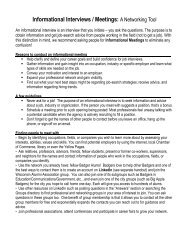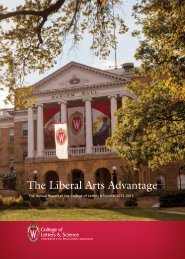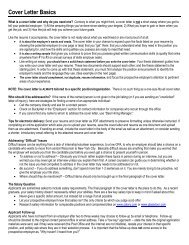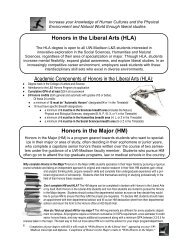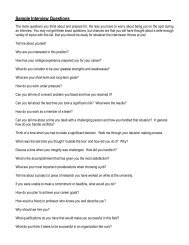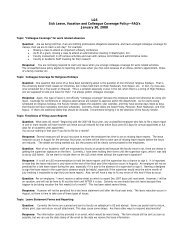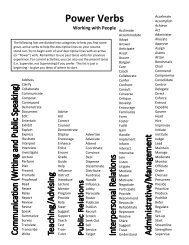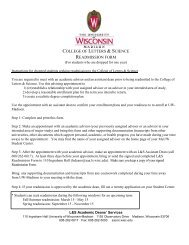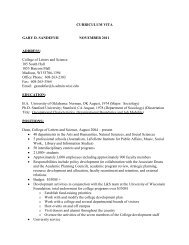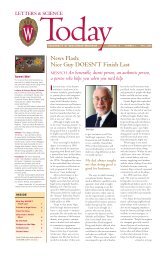resources on instruction in oral communication
resources on instruction in oral communication
resources on instruction in oral communication
Create successful ePaper yourself
Turn your PDF publications into a flip-book with our unique Google optimized e-Paper software.
Appendix: Strategies for Integrat<strong>in</strong>g Oral Communicati<strong>on</strong> <strong>in</strong>to the Comm-B Course(DRAFT)Speak<strong>in</strong>g-<strong>in</strong>tensive courses make <strong>oral</strong> communicati<strong>on</strong> a significant means for develop<strong>in</strong>gcourse material. In the traditi<strong>on</strong> of the Comm-B course, most speak<strong>in</strong>g-<strong>in</strong>tensive Comm-B courses will make <strong>oral</strong> communicati<strong>on</strong> part of the course methodology, as opposed tothe subject matter of the course. In other words, the course will most likely focus <strong>on</strong>teach<strong>in</strong>g the c<strong>on</strong>tent of the course and not <strong>on</strong> teach<strong>in</strong>g <strong>oral</strong> communicati<strong>on</strong> skills.At the same time, the speak<strong>in</strong>g-<strong>in</strong>tensive Comm-B course should <strong>in</strong>clude bothpreparati<strong>on</strong> for <strong>oral</strong> communicati<strong>on</strong> activities and regular evaluati<strong>on</strong> and feedback relatedto students’ <strong>oral</strong> work. As with any skill, <strong>oral</strong> communicati<strong>on</strong> competence is enhanced bya developmental learn<strong>in</strong>g strategy <strong>in</strong> which students receive guidance as they prepare for<strong>oral</strong> communicati<strong>on</strong> activities and are offered more than <strong>on</strong>e speak<strong>in</strong>g opportunity.Instructors must articulate guidel<strong>in</strong>es for effective <strong>oral</strong> communicati<strong>on</strong>, evaluate <strong>oral</strong>communicati<strong>on</strong> performance with respect to those guidel<strong>in</strong>es, and provide opportunitiesfor repeat<strong>in</strong>g activities and improv<strong>in</strong>g performance.Oral communicati<strong>on</strong> activities <strong>in</strong> the Comm-B course can take many forms. The purposeof this document is to provide examples of <strong>oral</strong> communicati<strong>on</strong> activities that can be usedas a series of assignments or <strong>in</strong> comb<strong>in</strong>ati<strong>on</strong> to enhance <strong>oral</strong> communicati<strong>on</strong> outcomes <strong>in</strong>the Comm-B course. This list is <strong>in</strong>tended <strong>on</strong>ly to suggest alternatives; other k<strong>in</strong>ds of <strong>oral</strong>communicati<strong>on</strong> activities or assignments are certa<strong>in</strong>ly possible.Oral Presentati<strong>on</strong>sThe <strong>oral</strong> presentati<strong>on</strong> encourages students to understand course material well enough tocommunicate it to others. In general, this category of assignment gives students anopportunity to speak to an audience from a positi<strong>on</strong> of expertise. Although the mostfamiliar form of the <strong>oral</strong> presentati<strong>on</strong> is the formal speech, some creative variati<strong>on</strong>s canmake <strong>oral</strong> presentati<strong>on</strong>s a more feasible part of the Comm-B course. In all cases,<strong>in</strong>structors should communicate expectati<strong>on</strong>s to students, evaluate <strong>oral</strong> presentati<strong>on</strong>s withrespect to clearly articulated criteria, and provide multiple performance opportunities.Course c<strong>on</strong>tent presentati<strong>on</strong>s, short form: To start a class meet<strong>in</strong>g, <strong>on</strong>e or twostudents are asked to review the theme, c<strong>on</strong>tent, or c<strong>on</strong>clusi<strong>on</strong>s of the previousclass sessi<strong>on</strong>. These presentati<strong>on</strong>s can be kept to a couple of m<strong>in</strong>utes each, andthey functi<strong>on</strong> to reorient the class for the day’s meet<strong>in</strong>g.Course c<strong>on</strong>tent presentati<strong>on</strong>s, l<strong>on</strong>g form: Students, perhaps work<strong>in</strong>g <strong>in</strong> pairs, areassigned the task of lead<strong>in</strong>g the class through some of the assigned material. Thisactivity reduces the tensi<strong>on</strong> between devot<strong>in</strong>g time to class c<strong>on</strong>tent and allow<strong>in</strong>g<strong>oral</strong> communicati<strong>on</strong> opportunities.
Debates: Students typically work<strong>in</strong>g <strong>in</strong> groups develop arguments for oppos<strong>in</strong>gpositi<strong>on</strong>s <strong>on</strong> an issue related to course c<strong>on</strong>tent. This assignment is particularlywell-suited to illum<strong>in</strong>at<strong>in</strong>g different sides of complex issues.Role-play<strong>in</strong>g: Students are asked to adopt the perspective of a scholar, character,or other pers<strong>on</strong>a relevant to the course c<strong>on</strong>tent and to represent that pers<strong>on</strong>’s po<strong>in</strong>tof view <strong>on</strong> the topic with<strong>in</strong> the class period devoted to the relevant material.Learn<strong>in</strong>g GroupsLearn<strong>in</strong>g group activities <strong>in</strong>volve creat<strong>in</strong>g a c<strong>on</strong>text <strong>in</strong> which communicati<strong>on</strong> with othersis <strong>in</strong>tegral to master<strong>in</strong>g course material, ga<strong>in</strong><strong>in</strong>g new <strong>in</strong>sights, and critical th<strong>in</strong>k<strong>in</strong>g. Aspeak<strong>in</strong>g-<strong>in</strong>tensive approach to learn<strong>in</strong>g groups and class discussi<strong>on</strong> <strong>in</strong>volves more thanmerely hav<strong>in</strong>g discussi<strong>on</strong> and us<strong>in</strong>g groups <strong>in</strong> class. Effective use of learn<strong>in</strong>g groupsrequires clearly articulated guidel<strong>in</strong>es for good discussi<strong>on</strong>s, an assessment of how<strong>in</strong>teracti<strong>on</strong>s are c<strong>on</strong>tribut<strong>in</strong>g to the achievement of learn<strong>in</strong>g objectives, and multipleopportunities for participati<strong>on</strong>. Although the most familiar form of the learn<strong>in</strong>g group isthe full class discussi<strong>on</strong>, variati<strong>on</strong>s <strong>on</strong> that format can enhance the educati<strong>on</strong>al benefits ofcommunicat<strong>in</strong>g with others <strong>in</strong> groups.Task GroupsClass discussi<strong>on</strong> with feedback: Supplement<strong>in</strong>g the traditi<strong>on</strong>al class discussi<strong>on</strong>format with written evaluati<strong>on</strong>s of students’ c<strong>on</strong>tributi<strong>on</strong>s provides the feedbackessential to <strong>oral</strong> communicati<strong>on</strong> skill development. As with any assignmentstudents complete regularly throughout the semester, evaluati<strong>on</strong> should befrequent, periodic, and related to clearly articulated performance criteria.Unstructured study groups: Students work<strong>in</strong>g <strong>in</strong> small groups spend class timeanalyz<strong>in</strong>g course c<strong>on</strong>tent or identify<strong>in</strong>g unresolved issues. This smaller groupvenue can provide a valuable c<strong>on</strong>text for develop<strong>in</strong>g ideas and explor<strong>in</strong>g thoughts<strong>in</strong> a collaborative envir<strong>on</strong>ment. As a f<strong>in</strong>al step, groups should reflect <strong>on</strong> how theircommunicati<strong>on</strong> with each other c<strong>on</strong>tributed to ga<strong>in</strong><strong>in</strong>g new <strong>in</strong>sights.Structured study groups: Students work<strong>in</strong>g <strong>in</strong> small groups are each assigned arole to play <strong>in</strong> the group deliberati<strong>on</strong>s (e.g., leader, facilitator, <strong>in</strong>formant). Thegroup then spends class time analyz<strong>in</strong>g course c<strong>on</strong>tent or identify<strong>in</strong>g unresolvedissues. As a f<strong>in</strong>al step, groups reflect <strong>on</strong> how their roles <strong>in</strong>fluenced theircommunicati<strong>on</strong> and their performance <strong>on</strong> the task.Task group activities require students to work together, usually outside of class, toaccomplish a task together. Bey<strong>on</strong>d us<strong>in</strong>g communicati<strong>on</strong> with others to ga<strong>in</strong> <strong>in</strong>sight, thetask group also creates a product that reflects their collective expertise and effort.Because task groups typically meet outside of class time to work <strong>on</strong> projects, they canoffer important opportunities for <strong>oral</strong> communicati<strong>on</strong> practice without compet<strong>in</strong>g withtime devoted to class c<strong>on</strong>tent. As with any <strong>oral</strong> communicati<strong>on</strong> activity, however,
<strong>in</strong>structors must devote time to articulat<strong>in</strong>g guidel<strong>in</strong>es for effective group communicati<strong>on</strong>and provide periodic performance evaluati<strong>on</strong>s.Research groups: Students work<strong>in</strong>g <strong>in</strong> groups collaboratively prepare a researchpaper or case analysis. The assignment should be sufficiently complex thatstudents can distribute parts of the task and must share resp<strong>on</strong>sibility for the f<strong>in</strong>alproduct. Periodic review and guidance with respect to communicati<strong>on</strong> and thegroup process is essential to keep research groups <strong>on</strong> track.Task-forces: Students work<strong>in</strong>g <strong>in</strong> groups design and implement a plan toaccomplish some goal. One example is CA 368: Theory and Practice ofPersuasi<strong>on</strong>, <strong>in</strong> which student groups mount persuasi<strong>on</strong> campaigns to accomplishan <strong>in</strong>fluence goal that relates to the theme selected by the class as a whole (e.g.,promot<strong>in</strong>g healthy behavior).Interpers<strong>on</strong>al Interacti<strong>on</strong>sInterpers<strong>on</strong>al communicati<strong>on</strong> activities <strong>in</strong>volve two students communicat<strong>in</strong>g together toc<strong>on</strong>vey <strong>in</strong>formati<strong>on</strong>, explore and develop their ideas, or accomplish a goal. In otherwords, this venue complements the functi<strong>on</strong>s of <strong>oral</strong> communicati<strong>on</strong> activities achievedby presentati<strong>on</strong>s, learn<strong>in</strong>g groups, or task groups. Interpers<strong>on</strong>al communicati<strong>on</strong> learn<strong>in</strong>gactivities are also particularly well-suited to promot<strong>in</strong>g <strong>in</strong>terview<strong>in</strong>g and listen<strong>in</strong>g skills.If opportunities for <strong>in</strong>terpers<strong>on</strong>al <strong>in</strong>teracti<strong>on</strong> are to enhance students’ communicati<strong>on</strong>competence, <strong>in</strong>structors must articulate guidel<strong>in</strong>es for effective face-to-face <strong>in</strong>teracti<strong>on</strong>,assess students’ communicati<strong>on</strong> performance, and provide opportunities for practice andimprovement.Role-play<strong>in</strong>g <strong>in</strong> dyads: Students work<strong>in</strong>g <strong>in</strong> pairs are assigned to particular rolesand c<strong>on</strong>duct a simulati<strong>on</strong> relevant to class material. The activity might <strong>in</strong>volvesimulat<strong>in</strong>g an employee-employer <strong>in</strong>teracti<strong>on</strong>, a cl<strong>in</strong>ical <strong>in</strong>terview, a c<strong>on</strong>flictresoluti<strong>on</strong> episode, etc. In this way, the role-play provides opportunities both toapply course material and to practice communicati<strong>on</strong> skills.Interviews: Students work<strong>in</strong>g <strong>in</strong> pairs <strong>in</strong>terview each other <strong>on</strong> some topic relatedto class material. This might <strong>in</strong>volve quizz<strong>in</strong>g each other <strong>on</strong> course c<strong>on</strong>tent orseek<strong>in</strong>g <strong>in</strong>formati<strong>on</strong> about each other relevant to the topic of the day. As a f<strong>in</strong>alstep, dyads should reflect <strong>on</strong> the effectiveness of <strong>in</strong>terview<strong>in</strong>g techniques for bothga<strong>in</strong><strong>in</strong>g <strong>in</strong>formati<strong>on</strong> and establish<strong>in</strong>g rapport.Learn<strong>in</strong>g dyads: Students work<strong>in</strong>g <strong>in</strong> dyads spend class time shar<strong>in</strong>g their po<strong>in</strong>tsof view <strong>on</strong> a topic and/or identify<strong>in</strong>g unresolved issues. This venue gives studentsan opportunity to develop their th<strong>in</strong>k<strong>in</strong>g and practice express<strong>in</strong>g their ideaswithout the pressure of the full class audience. Used <strong>in</strong> comb<strong>in</strong>ati<strong>on</strong> with classdiscussi<strong>on</strong>, the learn<strong>in</strong>g dyads can help students formulate ideas that they can thenmore easily express to the class.


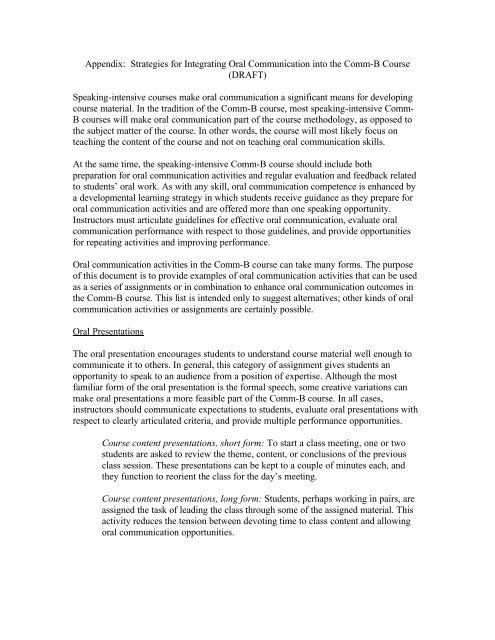
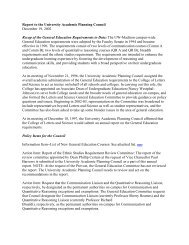
![Research Participant Information & Consent Form - Adults [pdf]](https://img.yumpu.com/50391200/1/190x245/research-participant-information-consent-form-adults-pdf.jpg?quality=85)
